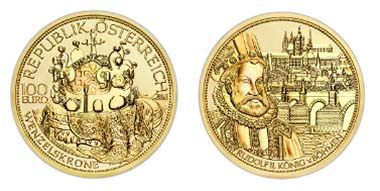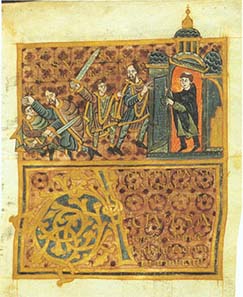November 10, 2011 – On November 9, 2011 the Austrian Mint has issued the fourth gold coin in the “Crowns of the House of Habsburg” series, featuring the mysterious crown of St. Wenceslas, crown of Bohemia. The crown is named in honor of St. Wenceslas, patron of Bohemia and the Czechs.
The obverse of the coin depicts the fantastic gold crafted crown, resting on a cushion draped with a silk cloth embroidered with a repeat pattern of the Bohemian coat of arms featuring its heraldic lion. Also located on this side of the coin are the country of issue “Republik Oesterreich” Republic of Austria, and the face value of 100 Euros, and the word “Wenzelskrone,” crown of St. Wenceslas. A ring of tiny pearls along the outer edge encircles both sides of the coin.
The reverse of the coin depicts Rudolf II in richly embroidered robes typical of the Renaissance period. Three statues, of the 30 that exist, along either side of the historic Charles Bridge are noted in the central design field. The Charles Bridge existing since the 1360’s was the most important crossing over the Vltava River; the waves of which are seen to the lower right of Rudolf. In the background parts of the old city of Prague are detailed. The castle of Prague, Hradschin, and the spires of the famous cathedral of St. Vitus, where the Wenceslas crown is secured, soar above the old city. Mint engraver Herbert Waehner designed both sides of the coin.
The Czech crown of Bohemia, the Wenceslas crown is not just any crown. Mystery surrounds it. The ominous legend that mysteriously envelops the crown states that of anyone, who wears it without the right to do so, will die within a year. Sadly, this myth seems to have proven to be true, even within the last 100 years. Therefore, the crown is securely locked behind not just one lock, but seven locks, deep within the cathedral. There are seven keys held by seven high-ranking officials of the church as well as the state. All seven must come together in order to gain access to the crown. It is very rare indeed; only happening 9 times during the 20th century.
The crown was originally crafted in 1347. The Wenceslas crown is made of 21 and 22 karat gold and weighs 2.5 kilos. The diameter is 19 centimeters. The crown has four panels, each with a fleur de lys design that are encrusted with 30 emeralds, 19 sapphires, 20 pearls and a large ruby. The crown comes together though two intersecting arches topped by a cross.
Wenceslas’ assassination: the duke flees from his brother (with sword) to a church, but the priest closes the door, Gumpold von Mantua, 10th century. Wolfenbüttel, Herzog August Bibliothek, Guelf. 11,2 Augusteus 4, fol. 21r. Source: Wikipedia.
Amongst the things Wenceslas was most known for was his habit of caring for the sick and destitute by personally visiting churches and giving alms not just to widows and orphans but also to prisoners. He was also known to harvest grain and bake communion wafers for the church. After his death the people of Bohemia spoke about his humble qualities and religious aura. A holy cult formed around Wenceslas the righteous king, one who has power by simply being pious.
Although Wenceslas was only a duke, during the reign of King Otto I (912-973), Otto posthumously recognized Wenceslas as King. The poplar Christmas carol “Good Kind Wenceslas” is inspired by the kind deeds of Wenceslas and maybe based on the words of a Czech poet put to music by Englishman John Neale.
There is a statue of Wenceslas on horseback in the main square of Prague, appropriately named Wenceslas square. It is here that in 1989, the end of communist rule was declared.
Rudolf is depicted on the coin since he had many similarities to Wenceslas. Both had the right to the Bohemian crown.
The new 100 Euro gold coin is struck in proof quality (reverse frosting) with a maximum mintage of 30,000 pieces. The coin has a diameter of 30 mm, contains 16 grams of gold and is .986 fine. Each coin is encapsulated and comes in a box with a numbered certificate of authenticity.
A unique lapel pin plated with gold and bearing a miniature version of the Crown of St. Wenceslas also accompanies the gold coin.
A wooden collection case with a red velvet insert on the lid bearing a miniature reproduction of a heraldic crown of an Austrian Archduke may be purchased separately for the series.
The series “Crowns of the House of Habsburg” will be continued next year, in November, with the final coin of the series featuring the Crown of the Austrian Empire.
Additional Background Information
Wenceslas (907-935) was born to the Duke of Bohemia, Vratislav who was a Christian, and to his mother, Drahomira. She was a pagan who was baptized when she married. Wenceslas’ father died when he was thirteen and therefore his Christian grandmother, Ludmilla, brought up Wenceslas. He was a well-educated intellectual who was patient and humble. His mother, who was entrusted with his guardianship and thereby ruled the land, tried to convert Wenceslas to paganism but was not effective against her mother-in-law, Wenceslas’ grandmother. Drahomira therefore had her murdered.
Wenceslas regained rule of Bohemia in 924 or 925. He had Drahomira exiled. Wenceslas was very much alone against alliances and disagreements that had been established during his mother’s rule. As a Christian he stood at the head of the country, which was basically pagan. Despite all this he founded the rotunda of St. Vitus that was consecrated and grew over the centuries to become St. Vitus Cathedral. However, politically Wenceslas did not enjoy many successes.
In 929, the East Frankish King Henry I advanced to Prague, and Wenceslas was able to peacefully negotiate an agreement with him, by agreeing to give annual tribute payments to Henry I. The seemingly unfair balance of power and lack of true independence angered Wenceslas’ brother Boleslaus, so much that he allied with other opposing nobles and had Wenceslas killed.
The exact year is unclear but it is thought that around the years 930-935, Boleslaus invited Wenceslas to the feast of Saints Cosmos and Damian. As Wenceslas was climbing the cathedral steps Boleslaus stabbed him with his sword. Wenceslas was able to wrestle the sword away from Boleslaus and then tried to seek shelter in the church of Stara Boleslav but the priest, who was part of Boleslav’s alliance, closed the door on him. Wenceslas died a martyr and thus he lives forever. What exactly Boleslav wanted to achieve is unclear. Wenceslas’ remains were transferred in the late 960’s to St. Vitus Cathedral, where they remain today.
Soon after the murder of Wenceslas, the people of Bohemia spoke about his humble qualities and religious aura. A holy cult formed around Wenceslas the righteous king, one who has power by simply being pious.
Rudolf is depicted on the coin since he had many similarities to Wenceslas. Both had the right to the Bohemian crown. Both were not particularly strong rulers and both had a brother who desperately wanted to usurp their rightful position.
Rudolf’s father Emperor Maximilian II named Rudolf as King of Bohemia in 1572. He was crowned with the Wenceslas crown in Prague in 1575. Upon his father’s death in 1576, Rudolf moved the imperial city from Vienna to Prague for the first time in Habsburg history. Rudolf II was tolerant of the many religious beliefs and cults of the time and he tried to bring people together under one Christian empire. His strong interests and patronage of the arts, astronomy, religion, philosophy, nature and the occult led to the many political problems during his reign. However his many interests are now regarded as key high points of the Renaissance period. He brought together in Prague many leading luminaries of the sciences and religion. His collection of arts and coins was the largest in Europe at the time. Rudolf dabbled in goldsmithing himself. Because of Rudolf’s personal interests, Prague became the intellectual and cultural center of Europe.
To listen to the Christmas carol about Wenceslas, please click here.
For more information on the Austrian Mint, visit its website.






